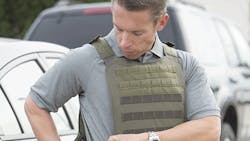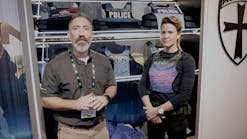Body Armor Upgrades: Active Shooter Events
Our columnist, Steve Smith, has documented school attacks dating back over 250 years. Not until the 1950s did we see such attacks being performed with firearms. In the mid-1960s we saw our first siege event on an American campus. In the late 1990s the Columbine active shooter event was viewable live on television via satellite coverage. Since 1999, after a public outcry about law enforcement response tactics, we in uniform have been training for a more immediate response to an active shooter attack. Make no mistake: this is a high risk event and, as such, we need to prepare ourselves as much as possible with both training and equipment. One equipment need that has been identified is higher threat level body armor.
Aren’t we at risk all the time? Don’t we wear body armor anytime we’re in uniform?
Yes. However, the armor we wear with our uniform is different from what we want to have going into an active shooter event. Why? Because of armor evolution and budget management solutions waiting to catch up.
Back in the late 1970s and early 1980s body armor for every day wear and use was optional in most places. If it was worn, it was quite often Level IIA because that was the only option that was reasonably comfortable for daily wear. Body armor was expensive by the standards at that time and it had to be so thick to provide higher levels of protection that it became uncomfortable. Also, in some minds, wearing body armor made an officer unnecessarily paranoid and those officers who wore it were sometimes viewed as “soft” or “scared.”
The armor that was available was considered usable for only five to 10 years (at the maximum) before it needed to be replaced. So we had an expensive product that provided minimum protection and needed to be replaced between two and five times in an officer’s career. That’s not very conducive to daily wear for the uniformed officer.
Fast forward to today and, thanks to technological advances in material production and product construction, we have Level III (actually IIIA, but commonly referred to as "Level III") body armor that is comfortable to wear each day, reasonably priced (by today’s standards) and not requiring replacement for 10 to 20 years. That means an officer can conceivably have just one set of armor that they wear for an entire career or, at most, need replacing one time. Certainly an officer’s life is worth that, right? There’s no arguing it.
If we’re already wearing Level IIIA body armor, why would we need to upgrade our armor for response to active shooter events? The better question: Why wouldn’t we?
Patrol work vs. active shooter
Think about the difference in circumstance between your day to day patrol work and the reality of entering an active shooter situation. Day to day you run the risk of running into someone who might shoot at you, more than likely with a handgun. In an active shooter event you are intentionally entering a high risk zone where someone is actively shooting at anyone they can find with whatever weapon(s) they brought. As compared to the “usual” street shooting, a rifle is more likely in an active shooter event and by your actions you’re making yourself a more likely target. Given the totality of the circumstances, yes, I want the highest threat level armor available. Since most concealed body armor is now Level IIIA, that means upgrading to Level III+ or Level IV prior to entering an active shooter event.
Let’s also consider the need for added equipment and a method for carrying it. Since the beginning of the active shooter response movement (for lack of a better term) we’ve known we needed to carry extra ammunition. We had three options: extra magazines for the rifle we were taking into the situation, extra magazines for our only weapon (our handgun), or spare magazines for both. No matter the situation, we needed a method to carry the extra ammo and what better way than on the up-armored vest we could grab conveniently out of our trunk.
In recent years the need to carry equipment for trauma care has also come to the forefront. That’s just more equipment we need a platform to carry. Once again, the up-armored equipment vest is the best viable solution.
Finally, thanks to an understanding of the dangers of back-face deformation and blunt force trauma, there’s a growing move to incorporate hard trauma plates into response armor. Adding trauma plates on top of your already worn and concealed Level IIIA armor usually makes your coverage Level IV PLUS. That plus can matter a lot if the shooter has a high caliber rifle or armor piercing ammunition.
A look at the ratings for our common Level IIIA body armor shows that it will stop most of the threats we’d face on the street or in an active shooter event, but only if it’s of sufficient thickness. With many officers wearing Level IIIA instead of Level III, what it will stop is reduced to handgun only calibers. In that case, it’s definitely recommended (I consider it mandatory) to upgrade with an external armor carrier when going into a high risk event. The external carrier could carry Level III+ armor, Level IV plates or both. The only thing we lose by wearing too much armor is comfort, provided the armor is cut to still allow for full mobility.
For active shooter responses, you should have an external armor carrier with either Level IIIA soft armor or Level IV plates or both in it. That carrier should also provide magazine pouches for your rifle magazines and handgun magazines or a method for carrying shotgun rounds if that’s what you’re using for your long gun. It should also carry, at a minimum, one tourniquet (for you) and a supply of hemostatic gauze for trauma care on scene at any active shooter incident. More is better until you become too burdened to move.

Lt. Frank Borelli (ret), Editorial Director | Editorial Director
Lt. Frank Borelli is the Editorial Director for the Officer Media Group. Frank brings 20+ years of writing and editing experience in addition to 40 years of law enforcement operations, administration and training experience to the team.
Frank has had numerous books published which are available on Amazon.com, BarnesAndNoble.com, and other major retail outlets.
If you have any comments or questions, you can contact him via email at [email protected].



